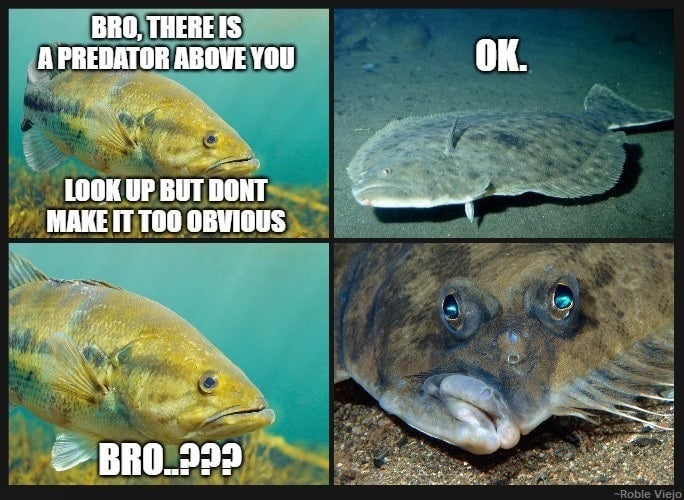How is it decided if they are left side up or right side up? There's one of each in this meme.
196
Be sure to follow the rule before you head out.
Rule: You must post before you leave.
I seem to remember their eyes slowly drift to one side
I looked into it and yes: https://1ft.io/proxy?q=https%3A%2F%2Fwww.nationalgeographic.com%2Fanimals%2Farticle%2Fflatfish-animals-science-colors-flounders
Flatfishes don’t start out flat. They start out looking like regular fish, kind of diamond shaped, and “as larvae, the eyes are in regular position on each side,” Burgess says.
As they develop “the eye begins to migrate, moving over the top of the head, eventually settling on one side or the other,” Burgess says. This also requires the bones in their heads to move. (Read about an early flatfish whose eye hadn't quite finished migrating.)
The flatfish’s bones are pretty pliable at this point, like the soft spot on an infant’s skull, so “as the eye moves, the bones in the head warp in that direction,” Burgess says.
An additional bone, found only in flatfish, develops right under the migrating eye, giving them that goofy asymmetrical look. (Watch a time-lapse video of the flatfish's amazing transformation.)
I also found interesting how they otherwise function:
Thanks to those pop-up peepers, “they can’t see the bottom directly underneath them, but they can see the bottom around them,” notes Jackie Cooper of the National Aquarium in Baltimore.
Their eyes can also move independently, widening their field of vision, Cooper says.
Once flatfish eyes get the lay of the land, they message the brain, which in turn sends signals back to the skin. This organ contains color-changing cells such as melanophores, which either expand or contract according to the background the fish is trying to match, Burgess says. (See pictures of fish glowing in neon colors.)
For instance, expanding their cells would make their color darker.
All this neurological relaying is “a pretty sophisticated thing to do,” Burgess says—not to mention it takes flatfish between two and eight minutes to blend in.
That was very interesting. Thanks!
But the question was what determines which eye moves?
A very local election.
Once flatfish eyes get the lay of the land, they message the brain, which in turn sends signals back to the skin
All this neurological relaying is “a pretty sophisticated thing to do,” Burgess says
Isn't that just the same response to visual stimulus that every animal with eyes does?
The context for those 2 sentences was changing colour to match your environment.
It varies by species. Some go left side up and others go right side up. In some species the individuals flip equally often to left and right, such as thornback turbot. Then there's the Senegalese sole... In this species the side they "tilt" towards are different between individuals, but most of them do it to one side and a small subgroup turn the other way. Kind of like our right or left handedness. source
might just be flipped
Just for the halibut
Flatfish are so hellish looking but so goddamn delicious
Fish look fucking creepy
